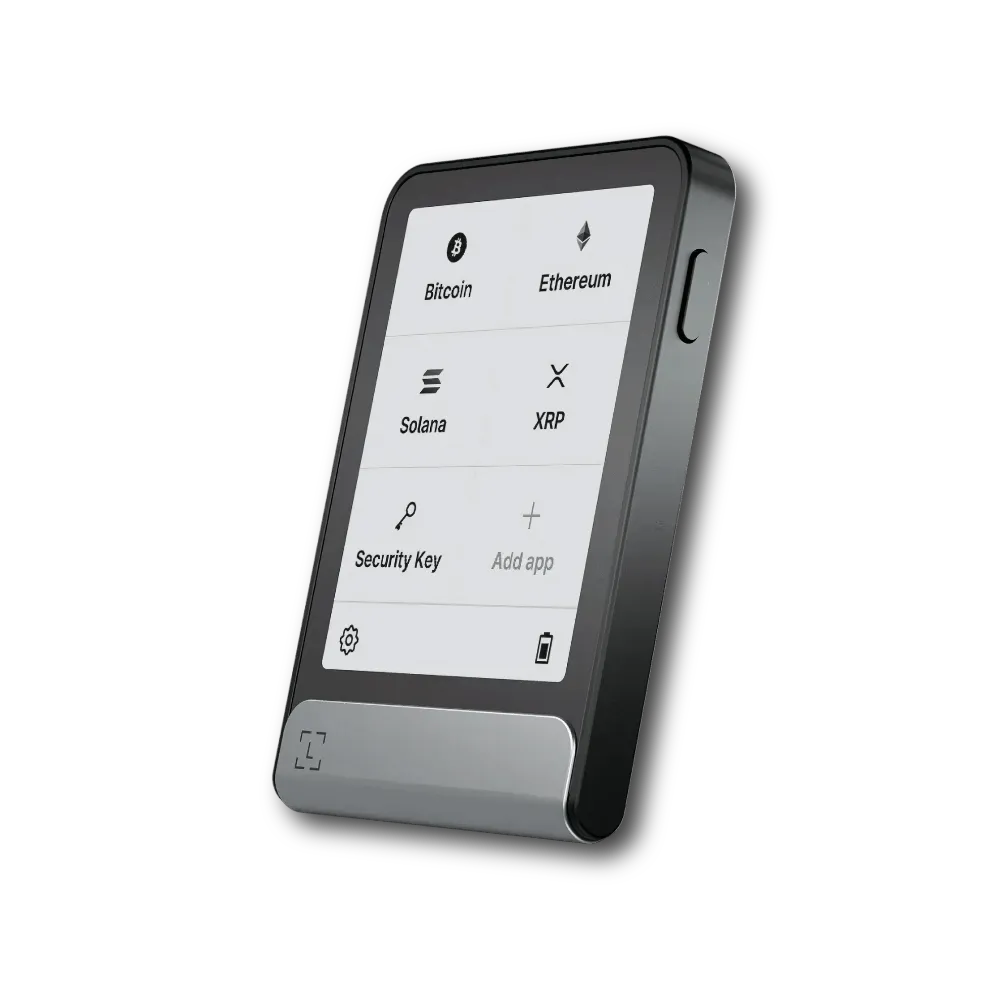
What is a Ledger Wallet?
Ledger produces hardware wallets – physical devices that store your cryptocurrency private keys offline, away from internet-connected devices. This “cold storage” approach significantly reduces the risk of hacking compared to software wallets. Since launching in 2014, Ledger has sold over 5 million devices worldwide, establishing itself as a market leader in crypto security solutions.
The company’s core philosophy centers on giving users complete control over their digital assets through secure, user-friendly devices. Unlike exchange wallets where a third party controls your keys, Ledger wallets ensure you maintain full ownership of your crypto – embodying the “not your keys, not your crypto” principle that’s fundamental to self-custody.
What Ledger Offers in 2025
Current Hardware Lineup
Ledger Nano X

- Bluetooth connectivity
- 100+ apps simultaneously
- Built-in battery (8 hours)
- Supports 5,500+ cryptocurrencies
- Secure Element chip (EAL5+)
Best for active traders managing diverse portfolios who need mobile access.
Ledger Flex

- Secure touchscreen interface
- Clear transaction signing
- Enhanced visual verification
- Intuitive user experience
- Latest security architecture
Ideal for users who prioritize ease of use and clear transaction visibility.
Ledger Live App
The Ledger Live companion app has evolved significantly since its launch. In 2025, it offers a comprehensive ecosystem for managing your crypto assets:

Asset Management
- Portfolio tracking
- Transaction history
- Market data integration
- Multiple account support
Trading Features
- Buy crypto directly
- Swap between assets
- Fiat on/off ramps
- DeFi integration
Advanced Features
- Staking for passive income
- NFT management
- dApp connections
- Ledger Recover backup service
Supported Cryptocurrencies
As of 2025, Ledger supports over 5,500 coins and tokens across multiple blockchains. This includes all major cryptocurrencies like Bitcoin, Ethereum, Solana, and Polkadot, plus thousands of ERC-20 tokens and NFTs. The company regularly adds support for new assets through Ledger Live updates.
Explore the Full Range of Ledger Products
Compare features and find the perfect hardware wallet for your crypto security needs.
Ledger Wallet Security: Still Top-Tier in 2025?
Security remains Ledger’s primary selling point, but how do their protections hold up in 2025’s threat landscape?
Core Security Architecture
Secure Element Chip
Ledger devices continue to use bank-grade Secure Element (SE) chips certified to EAL5+ standards. These specialized microcontrollers are designed to withstand sophisticated physical attacks and keep private keys isolated from the device’s operating system.
BOLOS Operating System
Ledger’s proprietary Blockchain Open Ledger Operating System (BOLOS) provides an additional security layer, preventing malicious code execution and ensuring only authorized applications can run on the device.
Key Security Features
- Offline Private Keys: Keys never leave the device, remaining isolated from internet-connected systems
- PIN Protection: Multiple failed attempts trigger a device reset
- Recovery Phrase Backup: 24-word seed for wallet recovery if your device is lost or damaged
- Ledger Recover: Optional subscription service for encrypted recovery phrase backup
- Anti-tampering Technology: Devices verify their integrity at each startup
- Open-source Applications: Community-verified code for transparency
The 2020 Data Breach: Lessons Learned
In 2020, Ledger suffered a significant data breach affecting their marketing database, exposing customer emails and physical addresses. It’s important to note that no crypto assets or private keys were compromised, as these are never connected to Ledger’s servers.
Since then, Ledger has implemented enhanced data protection measures, including:
- Improved data minimization practices
- Enhanced encryption for customer information
- Regular third-party security audits
- Expanded privacy-focused shipping options
2025 Security Enhancements
Ledger has continued evolving their security approach to address emerging threats:
- Advanced Phishing Protection: Built-in verification of transaction destinations
- Clear Signing: The Ledger Flex’s touchscreen provides enhanced transaction visibility
- Quantum Resistance Preparation: Ongoing updates to address future quantum computing threats
- Enhanced Supply Chain Verification: Improved authenticity checks to prevent counterfeit devices
Ledger Hardware vs. Software Wallets in 2025
How does Ledger stack up against other storage options in today’s crypto ecosystem?
Ledger Hardware Wallets
- Private keys stored offline in secure chip
- Physical verification required for transactions
- Immune to online malware and remote attacks
- One-time purchase with long lifespan
- Supports thousands of cryptocurrencies
- Recovery possible with seed phrase
Software Wallets (MetaMask, Trust)
- Private keys stored on internet-connected device
- Convenient access from any device
- Vulnerable to malware and phishing
- Free to use
- Typically supports fewer cryptocurrencies
- Recovery possible with seed phrase
Trezor (Competitor)
- Private keys stored offline
- Open-source hardware and software
- Physical verification for transactions
- One-time purchase
- Supports thousands of cryptocurrencies
- Recovery possible with seed phrase
Key Differentiators in 2025
Ledger Advantages
- Secure Element chip (bank-grade security)
- More intuitive user interface
- Bluetooth connectivity (Nano X)
- Touchscreen display (Flex model)
- Comprehensive Ledger Live ecosystem
Potential Drawbacks
- Higher price point than software wallets
- Proprietary (not fully open-source)
- Physical device can be lost or damaged
- Learning curve for beginners
- Requires physical presence for transactions
“Hardware wallets like Ledger remain the gold standard for serious crypto investors in 2025. While software wallets have improved their security, they still can’t match the fundamental protection of keeping private keys completely offline.”
— Alex Gladstein, Chief Strategy Officer at the Human Rights Foundation
Ease of Use & Setup in 2025
Ledger has made significant strides in simplifying the user experience while maintaining security.
Initial Setup Process
- Unbox your Ledger device and connect it to your computer or smartphone
- Install the Ledger Live application on your preferred device
- Follow the on-screen instructions to set up your PIN code
- Write down your 24-word recovery phrase on the provided card
- Install applications for your preferred cryptocurrencies
- Transfer your assets to your new secure addresses
Everyday Usage Experience
Managing Assets
The Ledger Live dashboard provides a comprehensive overview of your portfolio, with real-time valuation and performance tracking. Adding new cryptocurrencies requires installing the corresponding app on your device, which is a straightforward process through Ledger Live.
Executing Transactions
Sending crypto requires physical verification on your Ledger device, adding a crucial security layer. The Ledger Flex’s touchscreen makes this process more intuitive by clearly displaying transaction details, while the Nano X offers the same security with a more compact interface.
Platform Compatibility
Ledger devices work across multiple platforms:
Desktop
- Windows 10+
- macOS 10.15+
- Linux
Mobile
- iOS 13.4+
- Android 8.0+
- Bluetooth (Nano X only)
Web Interfaces
- Chrome
- Firefox
- Brave
- Edge
Is Ledger Still Worth Buying in 2025?
The value proposition of Ledger wallets varies depending on your crypto involvement and security needs.
For Long-term Holders

Worth it: If you’re holding significant crypto assets as a long-term investment, the one-time cost of a Ledger device provides peace of mind that far outweighs the expense. The security benefits compound over time.
- Protection from exchange failures
- Immunity to online hacking attempts
- Complete control over your assets
- One-time purchase for years of security
For DeFi Users

Worth it: DeFi users interact with multiple protocols and smart contracts, increasing their attack surface. Ledger provides crucial transaction verification that can prevent costly mistakes and malicious contract interactions.
- Clear transaction verification
- Protection from malicious contracts
- Support for major DeFi platforms
- Blind signing controls for advanced users
For NFT Collectors

Worth it: With high-value NFTs becoming significant investments, hardware security is increasingly important. Ledger’s NFT viewing and management features provide both security and functionality.
- Secure storage of valuable NFTs
- NFT visualization in Ledger Live
- Safe marketplace interactions
- Protection from NFT phishing scams
Pros
- Industry-leading security standards
- Intuitive user interface
- Comprehensive ecosystem with Ledger Live
- Regular updates and new coin support
- Improved transaction visibility (Flex model)
- Strong track record since 2014
Cons
- Higher price point than software alternatives
- Physical device can be lost or damaged
- Company’s 2020 data breach damaged trust
- Not fully open-source
- Learning curve for complete beginners
- Additional step required for transactions
Ready to Secure Your Crypto Assets?
Get the peace of mind that comes with industry-leading hardware security.
Pricing & Where to Buy
| Model | Price (USD) | Key Features | Best For |
| Ledger Nano X | $149 | Bluetooth, 100+ apps, battery | Active traders, mobile users |
| Ledger Flex | $279 | Touchscreen, clear signing | Security-focused users who value visibility |
| Ledger Nano S Plus | $79 | USB-C, larger screen, 100+ apps | Budget-conscious investors |
Important Security Warning
Always purchase Ledger devices directly from the official Ledger website or authorized retailers. Never buy used or discounted devices from unauthorized third-party sellers, as they may be compromised. Ledger devices should arrive in sealed packaging with tamper-evident stickers intact.
Authorized Purchase Channels
- Official Ledger Website: The safest option with direct shipping
- Authorized Retailers: Check Ledger’s website for the official list
- Ledger Amazon Store: Official Ledger-managed storefront
Protect Your Crypto Investment
Secure your digital assets with genuine Ledger hardware wallets.
Final Verdict: Is Ledger Still Worth It in 2025?
Despite the evolving crypto landscape, Ledger hardware wallets remain a worthwhile investment in 2025 for anyone serious about cryptocurrency security. The company has maintained its security edge while improving usability and expanding its ecosystem.
For long-term investors, DeFi users, and NFT collectors, the protection offered by Ledger’s offline storage significantly outweighs the upfront cost. The Ledger Flex’s touchscreen represents a meaningful evolution in hardware wallet design, making security more accessible to mainstream users.
While software wallets and exchange custody solutions have improved, they still can’t match the fundamental security of keeping private keys completely offline in a specialized secure element. In a world of increasing digital threats, Ledger’s approach to crypto security remains as relevant as ever.
Who Should Buy a Ledger Wallet in 2025?
- Investors holding significant crypto assets (>$1,000)
- Anyone concerned about exchange security or third-party custody
- DeFi users interacting with multiple protocols
- NFT collectors with valuable digital assets
- Privacy-focused individuals who value self-custody
- Long-term crypto holders planning for years of secure storage
Take Control of Your Crypto Security
Join millions of users who trust Ledger to protect their digital assets.
Explore Ledger Wallets
Learn How Ledger Works
Crypto Wallets 2025
